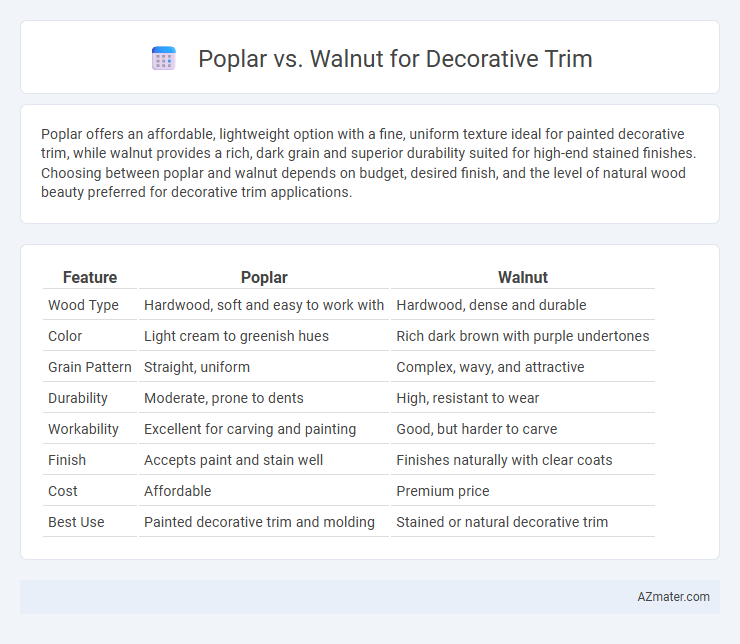Poplar offers an affordable, lightweight option with a fine, uniform texture ideal for painted decorative trim, while walnut provides a rich, dark grain and superior durability suited for high-end stained finishes. Choosing between poplar and walnut depends on budget, desired finish, and the level of natural wood beauty preferred for decorative trim applications.
Table of Comparison
| Feature | Poplar | Walnut |
|---|---|---|
| Wood Type | Hardwood, soft and easy to work with | Hardwood, dense and durable |
| Color | Light cream to greenish hues | Rich dark brown with purple undertones |
| Grain Pattern | Straight, uniform | Complex, wavy, and attractive |
| Durability | Moderate, prone to dents | High, resistant to wear |
| Workability | Excellent for carving and painting | Good, but harder to carve |
| Finish | Accepts paint and stain well | Finishes naturally with clear coats |
| Cost | Affordable | Premium price |
| Best Use | Painted decorative trim and molding | Stained or natural decorative trim |
Introduction to Poplar and Walnut for Decorative Trim
Poplar is a lightweight hardwood known for its smooth texture and pale, uniform coloration, making it an excellent choice for decorative trim that can be easily painted or stained. Walnut offers a rich, dark brown hue with distinctive grain patterns, providing a luxurious and natural aesthetic ideal for high-end decorative trim applications. Both woods balance durability with visual appeal, but poplar is preferred for cost-effective, versatile finishes while walnut is favored for showcasing natural beauty.
Key Characteristics of Poplar Wood
Poplar wood is known for its lightweight and straight grain, making it easy to work with for decorative trim applications. Its pale, uniform color accepts paint exceptionally well, allowing for smooth finishes that enhance intricate details. Poplar also offers moderate stability and affordability compared to walnut, making it a practical choice for budget-conscious projects.
Key Characteristics of Walnut Wood
Walnut wood is prized for its rich, deep brown color with purplish undertones and smooth, fine grain, making it ideal for high-end decorative trim. Its durability and hardness provide excellent resistance to wear and dents, ensuring long-lasting elegance in architectural details. Walnut also accepts stains and finishes exceptionally well, enhancing its natural beauty and adding a luxurious touch to interior design.
Aesthetic Differences: Poplar vs Walnut
Poplar offers a light, creamy color with subtle green or yellow undertones, providing a smooth and uniform appearance that easily adapts to paints and stains for versatile decorative trim options. Walnut features a rich, deep brown hue with intricate grain patterns and natural variations, creating a luxurious and classic aesthetic that enhances traditional and modern interiors alike. The choice between poplar and walnut for decorative trim hinges on whether a bright, neutral backdrop or a striking, warm accent is desired to complement the overall design scheme.
Durability and Strength Comparison
Poplar offers moderate durability and strength, making it suitable for decorative trim in low-traffic areas, while walnut provides superior hardness and resistance to dents and scratches, ensuring longer-lasting performance. Walnut's dense grain structure enhances its ability to withstand wear, whereas poplar is more prone to dents and may require frequent maintenance. For projects demanding robust, durable trim, walnut is the preferred choice due to its exceptional strength and resilience.
Workability and Ease of Installation
Poplar offers superior workability for decorative trim due to its softer texture and uniform grain, allowing for easier cutting, shaping, and sanding compared to walnut. Walnut, though valued for its rich color and durability, is harder and denser, which can result in longer installation times and increased tool wear. Choosing poplar ensures smoother handling during installation and reduces the risk of splitting or chipping, making it ideal for intricate trim profiles.
Cost Comparison: Poplar vs Walnut
Poplar offers a significantly lower cost compared to walnut, making it an economical choice for decorative trim without sacrificing quality. Walnut, known for its rich color and grain, commands a premium price due to its durability and aesthetic appeal. Budget-conscious projects often favor poplar for its affordability, while high-end finishes lean towards walnut despite the higher expense.
Finishing Options and Staining Results
Poplar offers a smooth, uniform grain that readily accepts paint and stains, making it ideal for decorative trim requiring a flawless finish or vibrant colors. Walnut features a rich, dark brown hue with natural variations, enhancing its appeal with clear or light stains that highlight its unique grain patterns while avoiding heavy pigments that can obscure detail. Both woods respond well to sealing and topcoating, but poplar's lighter tone allows greater flexibility in staining, whereas walnut's natural beauty shines best with finishes that preserve its depth and warmth.
Best Applications for Each Wood Type
Poplar offers a smooth surface ideal for painted decorative trim, providing a cost-effective option that resists warping in interior settings. Walnut features rich, dark tones and distinctive grain patterns, making it perfect for high-end stained trim applications that highlight natural wood beauty in luxury interiors. Poplar suits modern, budget-conscious projects with a need for uniformity, while walnut excels where aesthetic impact and durability are prioritized in decorative woodwork.
Choosing the Right Wood for Your Decorative Trim
Poplar offers a smooth surface ideal for painted decorative trim due to its affordability and ease of finishing, while walnut provides a rich, dark grain that enhances natural wood aesthetics with durability. Walnut's higher cost and distinct grain pattern suit high-end decor, whereas poplar is better for versatile, budget-conscious projects requiring a crisp, clean look. Selecting the right wood depends on whether the trim emphasizes painted surfaces or natural wood beauty and the desired balance between cost and visual impact.

Infographic: Poplar vs Walnut for Decorative Trim
 azmater.com
azmater.com